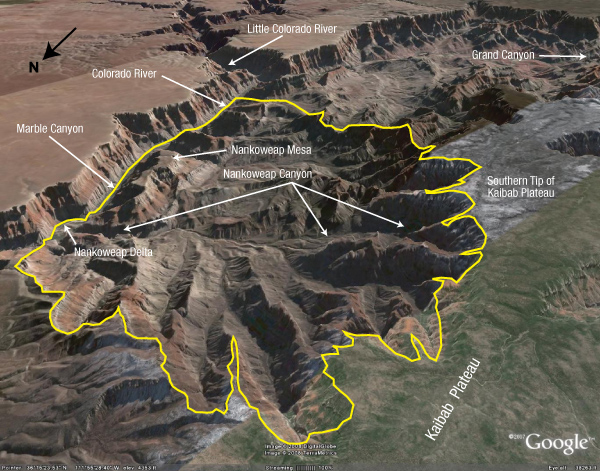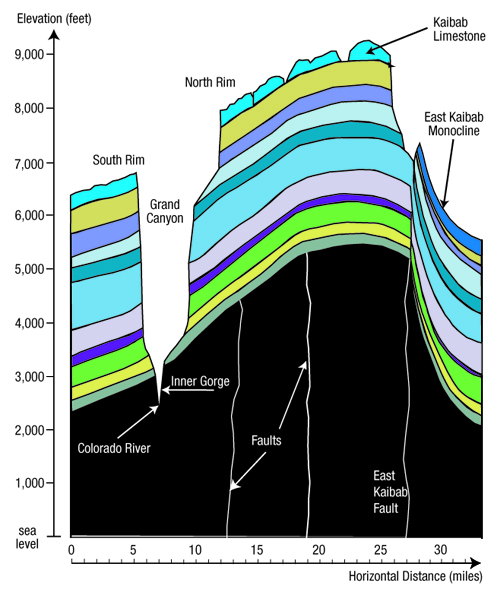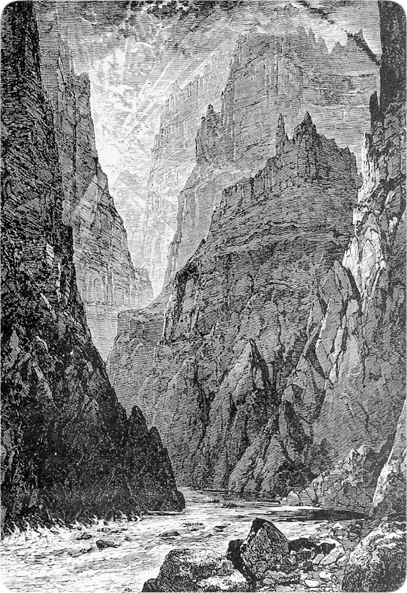Below is the online edition of In the Beginning: Compelling Evidence for Creation and the Flood,
by Dr. Walt Brown. Copyright © Center for Scientific Creation. All rights reserved.
Click here to order the hardbound 8th edition (2008) and other materials.
| See Bryan Nickel’s excellent, partially animated summary of this chapter at: https://www.youtube.com/watch?v=DZ4eVMd3_PE&feature=youtu.be |
The Origin of the Grand Canyon
SUMMARY: Geologists admit that they do not know how the Grand Canyon formed, but for the last 140 years, they have insisted that the Colorado River carved the canyon over millions of years and somehow removed the evidence.2 (Obvious problems with this idea are mentioned in Figure 43’s description on page 112.) To these so-called experts, the canyon’s birth remains a “hazy mystery, cloaked in intrigue, and filled with enigmatic puzzles.”3 After studying those puzzles, we will examine the eight main proposals for the Grand Canyon’s origin and see why they are rejected by almost all experts. Finally, we will consider two ancient, postflood lakes—Grand Lake and Hopi (HO-pee) Lake—that several centuries after the flood, breached their boundaries and carved the Grand Canyon in weeks. This explanation not only unravels the confusion, but solves other major puzzles not previously associated with the Grand Canyon. For a quick explanation, see Figure 123 on page 221.
The Grand Canyon is the best and most famous earth-science laboratory in the world. Although a few canyons are deeper or longer or steeper or wider, none is deeper and longer and steeper and wider—and none can compare with the Grand Canyon’s scenic variety, massiveness, beauty, and three-dimensional exposure. It is 216 miles long,4 4–18 miles wide, and about 1 mile deep. Writers correctly describe the canyon in such lofty terms as magnificent, majestic, stupendous, inspirational, sublime, breath-taking, awesome, spellbinding, and earth’s greatest celebration of geology. The first reaction of most of the 6 million annual visitors to the canyon is stunned silence.
Probably the foremost question visitors have is, “How did this happen?” Bruce Babbitt, former Governor of Arizona (1978–1987) and U.S. Secretary of the Interior (1993–2001), relates the answer given by John Hance. In 1883, Hance became the first white settler in the Grand Canyon. He was one of the canyon’s most colorful personalities, tour guides, and explorers.
Children loved John Hance, and to them he always explained how the canyon came into being. “I dug it,” he would say simply. This story worked well for years until one little four-year-old girl asked seriously, “And where did you put the dirt?” Hance had no ready answer; he never used that story again. But it bothered him the rest of his life, and when he was dying he whispered to his waiting friends, “Where do you suppose I could have put that dirt?” 5
That question still bothers geologists, because if the Colorado River carved the canyon, as commonly assumed, that dirt would have formed a gigantic river delta where the Colorado River enters the Gulf of California. Instead, the delta is relatively tiny—certainly compared to the vast volume of sediments that were removed to form the canyon.
Colorado River. Actually, the puzzle is much more difficult. Geologists now agree that the Colorado River began flowing out of the western Grand Canyon only recently. Here’s why. Before the Glen Canyon Dam was built upstream from the Grand Canyon in 1963, the gritty Colorado River carried an average of 550,000 tons of sediment (sand, silt, and clay) out of the canyon each day—more than 5 tons each second!6 West of the Grand Canyon, the Colorado River cuts through a 650-foot-thick layer of Hualapai (WALL-uh-pie) Limestone whose topmost layers have been dated, using radiometric techniques, as less than 5,900,000 years old.7 If the river flowed through a lake that supposedly deposited this almost pure limestone, why are common river sediments not found in that limestone?8 Obviously, the river must have begun flowing there after that limestone was deposited—in geologic terms, recently. How recently? According to most geologists, within the last one-thousandth of the earth’s history!9
Three different pairs of similar, water-transported rocks are on opposite sides of the western Grand Canyon—rocks that could not have been transported from one side to the other if the canyon blocked the way.10 Therefore, those rocks were first transported, then the Grand Canyon was cut through them and the Colorado River began flowing out of the western end of the Canyon. Since 1934, geologists have been trying unsuccessfully to find a previous location for the river or to learn why the river began so recently.11
Kaibab (KI-bab) Plateau. A quick look at a relief map raises another question. Why and how did the powerful Colorado River, flowing southward into northern Arizona along the east side of the Kaibab Plateau, suddenly make a right turn and flow west, up and over (or through) the high Kaibab Plateau? Rivers don’t flow uphill. Desert View, an overlook on the Kaibab Plateau just south of the Colorado River, rises 5,800 feet above the river. Just across the river, the land rises even higher.
All explanations for the Grand Canyon’s origin try to answer this question.12 Some say the river was once a mile or more higher, and the land it flowed over eroded away. As it did, the river settled down on top of the Kaibab Plateau and cut through it—a process called superposition. Others say the river cut through the Kaibab Plateau along a fault (or crack). However, faults are generally perpendicular to the Colorado River, not parallel. Some believe that the land under the river rose, forming the Kaibab Plateau. As it did, the river cut down through the rising plateau. Two theories say that a stream flowing down a western slope of the Colorado Plateau continually eroded eastward 130 miles and eventually cut through the Kaibab Plateau—a process called headward erosion. (Notice how dependent these explanations are on millions of years of time, and how many untestable explanations can be proposed if millions of years are imagined.)
Missing Mesozoic Rock. Actually, cutting through the Kaibab Plateau is a relatively minor problem, and carving the entire Grand Canyon is not even half the problem. The Grand Canyon’s rim consists of hard Kaibab Limestone, typically 350 feet thick. When you walk to the canyon’s edge to look down, you are standing on Kaibab Limestone. It extends away from the canyon in all directions, covering about 10,000 square miles. However, rising 1,000 feet above this Kaibab Limestone at a few dozen isolated spots are softer (crumbly or weakly cemented) Mesozoic rocks; they are always capped on top by a very hard rock, such as lava. Obviously, lava did not flow up to the top; lava, which flows downhill, collected in a depression and hardened. Later, a fast-moving sheet of water flowed over northern Arizona and swept all the soft Mesozoic rock off the hard Kaibab Limestone—except for the few dozen spots capped and protected by hard rock.
Why must it have been a sheet of water? Falling rain would cut only channels. Flowing rivers or streams, even if they meandered for millions of years, would not uniformly sweep 1,000 feet or more of material off almost all of these 10,000 square miles of the fairly flat Kaibab Limestone. Besides, meandering rivers would produce meandering patterns. Therefore, before you can excavate 800 cubic miles of rock below the rim to form the Grand Canyon, something must sweep off almost all the Mesozoic rock above—a much larger excavation project. Surprisingly, the Mesozoic rock has also been swept off the Kaibab Plateau. How could water get so high? As you will see, the sweeping process—the Great Denudation—occurred before the Kaibab Plateau rose.
Marble Canyon. To form the Grand Canyon requires first forming Marble Canyon, which is directly upstream (northeast) of the Grand Canyon. The two canyons join where the Little Colorado River enters the Colorado River. John Wesley Powell, who led the first known expedition through these canyons in 1869, mistakenly thought some of the water-polished limestone he saw was marble, so he named the canyon Marble Canyon. Marble Canyon is straighter, narrower, shorter (61 miles long), and has steeper walls. The two canyons are like two adjoining pipes; any explanation for one pipe should also explain the other pipe, even if they have differing shapes.
All the thin strata in and around Marble Canyon tip in directions that form a curious, but consistent, pattern. People floating southward inside Marble Canyon sense that they are falling. That sensation is caused by an optical illusion. The strata inside the walls of Marble Canyon tip up to the south, so as one floats downstream, one rapidly moves past lower and lower layers in the narrow walls to the immediate left and right. Relative to a fixed point on the ground, one is actually dropping only about 8 feet each mile, a hardly perceptible rate.
If we look closely, we can see that the layers in Echo Cliffs (to the east) and Vermilion Cliffs (to the west) tip up toward Marble Canyon. At the southern end of these cliffs, the layers also tip up to the south, toward the Grand Canyon 30 miles away. [See Figure 127 on page 224.]
Another unusual feature of these cliffs and others in the region is the lack of rubble, called talus, at the base of the cliffs. If freezing and thawing cycles acted for millions of years on the cliff faces, a sloping pile of loose rocks should be at the base of the cliffs. Even if the cliffs were young, the process of lifting up or carving cliffs should have left considerable talus.
Side Canyons. Dozens of large side canyons intersect the main trunk of Grand and Marble Canyons and cut down to the level of the Colorado River. If it took the powerful Colorado River millions of years to carve the Grand Canyon, why do all these side canyons, with no visible source of water, also cut down to the Colorado River? These side canyons also have their own side canyons, all connected like branches on a big, bushy tree.
Had these side canyons formed before the main trunk of Grand and Marble Canyons, most would extend through to the opposite side of the main trunk. They don’t. Had these side canyons formed after Grand Canyon and Marble Canyon formed, many would not cut down to the Colorado River, especially with no visible source of water to carve them. Therefore, these side canyons probably formed at the same time as Grand and Marble Canyons.
Some side canyons, called slot canyons, are much narrower than they are high. [See Figure 141 on page 235.] How could such narrow canyons be carved so deeply through hard rock?
A few side canyons are “barbed.” That is, they connect to the main canyon “backwards,” similar to the barbs in barbed wire or fishhooks. Tributaries almost always enter rivers at acute angles, but the barbed canyons are oriented at obtuse angles. Very strange.15 What happened?

Figure 120: Nankoweap—Region of Unusual Erosion. This view is looking southeast from 38,000 feet above the ground. The Little Colorado River enters the southern end of Marble Canyon at the top center. The yellow line encloses a region of unusual erosion. Notice that on the top of the high Kaibab Plateau, streams do not flow into the many canyons that are cut into this southeastern portion of the Kaibab Plateau. So, what cut these side canyons, and why are they in such a localized area? Why would the terrain east of Marble Canyon, which is at least 2,000 feet below the top of the Kaibab Plateau and most of this erosion, be so smooth? On top of Nankoweap Mesa are slumps, landslides, and rockfalls. How can rocks fall and mud flow onto the top of a mesa?
Nankoweap Canyon. One large side canyon, Nankoweap (NAN-ko-weep) Canyon, enters the Colorado River from the west, near the southern end of Marble Canyon. [See Figure 120.] Nankoweap Canyon has at least 40 archaeological sites, including granaries, but today is usually dry and barren, although, at times, Nankoweap Creek flows.
Nankoweap Canyon begins high on the southeastern slope of the Kaibab Plateau. Water flowing from many directions cut this side canyon and its many tributaries producing avalanches and mud flows. The mineral composition of the boulders mixed in this debris show that the avalanche came out of and off the Kaibab Plateau. These flows had to be voluminous, recent, violent, and fast. The flow was voluminous and recent, because it produced Nankoweap Delta, the Grand Canyon’s largest tributary delta. If, as some mistakenly believe, the Colorado River was powerful enough to cut through solid rock and carve the entire canyon, why did it not remove this soft delta? The flow was violent and fast, because large, partially rounded boulders lie up to 200 feet high on both sides of the last 1,000 feet of Nankoweap Creek. Some of the lower boulders are taller than a man.16
The Great Unconformity. Fossils are found only in the layers above an almost perfectly horizontal plane named the Great Unconformity. In the Grand Canyon, it lies about 4,000 feet below the rim and is exposed above the Colorado River for 66 miles. Above the Great Unconformity the layers are all sedimentary and almost always horizontal; below the Great Unconformity lie either basement rock or thick, steep (10°–20° slope) sedimentary layers with no fossils.
Arching. Researchers have long noted that Grand Canyon and Marble Canyon lie on a long, 277-mile arch. Vertical cross sections (perpendicular to the Colorado River) show how the sedimentary layers and basement rock directly below, arch upward.18

Figure 121: Grand Canyon Profile. This profile, showing the thickness, shape, and elevation of each of the major sedimentary layers, extends from 36°00'N, 112°17'W to 36°24'N, 111°56'W.17 Basement (nonsedimentary) rock is in black. Note the differing scales (vertical in feet and horizontal in miles). At these scales, the Colorado River, at the tip of the left arrow above, would be smaller than the period at the end of this sentence. (Could that “dot of a river” carve the huge, wide canyon above it?) In general, Grand and Marble Canyons cut down into a broad arch that extends for the length of those canyons. This particular profile cuts across faults; one of the most dramatic aligns with the East Kaibab Monocline, which will be discussed later. Notice how the layers under the monocline thicken to the right.
Each cross section differs slightly, depending on where it is drawn. For 46 miles along the highest portion of the arch, the canyon descends into the dark basement rock itself—a steep slot (up to 1,200 feet deep) called the inner gorge. [See Figures 121 and 122.] Immediately above this inner gorge lies the Great Unconformity, and above that boundary lie horizontal sedimentary layers stacked almost a mile high.

Figure 122: Inner Gorge. How could a river cut a slot, up to 1,200 feet deep, into such hard, crystalline (non-sedimentary) rock? When a river erodes down through soft sedimentary layers and encounters hard basement rock, further erosion should be primarily horizontal, into the softer, flanking sedimentary layers. Any erosion into the harder rock would form a shallow, bowl-shaped channel, not a deep, nearly vertical cut.The eroded walls of this inner gorge should be smooth, but instead are jagged. Besides, if the river started to cut a deep slot, boulders (not easily moved by even a fast-flowing river) would fill the bottom of that slot, preventing further scouring and deepening of the slot. [See in Figure 121 what appears to be a deep tension crack that formed as the mile-deep sedimentary layers were eroded to form the Grand Canyon. With that removal of weight, the basement rock below the Canyon arched up and cracked vertically.
Our Focus. While the key question concerning the Grand Canyon is how did it form, other matters can easily distract us: the canyon’s beauty, modern history, early habitation, and exploration; the mind-numbing list of geologic terms and terrain names; and the adventure and stress of navigating its many trails and the Colorado River itself. Hundreds of books have already told these stories, so we will avoid those fascinating diversions and focus on the key question of the Grand Canyon’s origin. A reward may await us. As usually happens in science—and as you are hopefully seeing with the flood itself—when a persistent enigma is finally solved, answers to seemingly unrelated problems become obvious.